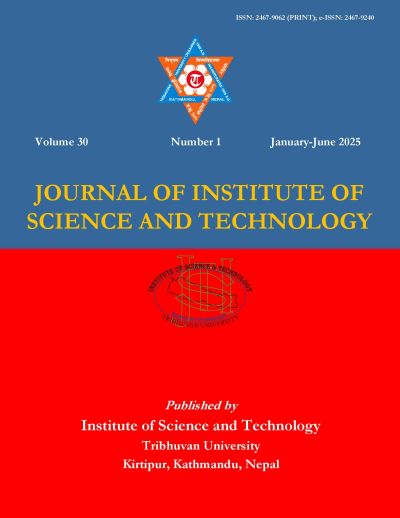First Principles Study of NaCl···A-B Type (A-B = Acceptor) Complexes
DOI:
https://doi.org/10.3126/jist.v30i1.68199Keywords:
Atoms in molecules, first principles study, sodium bondingAbstract
A first-principles study of NaCl•••A-B type (A-B =acceptor) complexes was performed using ab initio methods and the Atoms in Molecules (AIM) approach. We have considered ten different acceptors: C2H4, NH3, H2O, H2, HF, HNa, HLi, FNa, FLi, NaCl. This work reports whether these complexes form sodium bonds by examining sodium bond distances, bond angles, frequency shifts, binding energies, and topological parameters (electron density and Laplacian of electron density at sodium bond critical points). We calculated binding energies by correcting for both basis set superposition error and zero-point vibrational energies. Our findings reveal both red and blue shifts in the stretching frequency modes. The value of electron density and the value of the Laplacian of the electron density are consistent with earlier reports on sodium bonding. This study further shows that sodium bond distances are more closely related to ionic radii than to van der Waals radii, with notable differences compared to hydrogen bond radii. All these results provide the nature of sodium bonding, and its unique characteristics compared to other non-covalent interactions.
Downloads
References
Adhav, V.A., & Saikrishnan, K. (2023). The realm of unconventional noncovalent interactions in proteins: their significance in structure and function. ACS Omega, 8(25), 22268-22284. https://doi.org/10.1021/acsomega.3c00205.
Arunan, E., Desiraju, G.R., Klein, R.A., Sadlej, J., Scheiner, S., Alkorta, I., ... & Nesbitt, D.J. (2011). Definition of the hydrogen bond (IUPAC Recommendations 2011). Pure and Applied Chemistry, 83(8), 1637-1641. https://doi.org/10.1351/PAC-REC-10-01-02.
Arunan, E., Metrangolo, P., Resnati, G., & Scheiner, S. (2024). IUPAC Recommendations:(Un) equivocal Understanding of Hydrogen and Halogen Bonds and Their (Un) equivocal Naming!. Crystal Growth & Design, 24(20), 8153-8158. https://doi.org/10.1021/acs.cgd.4c00982.
Ault, B.S. (1978). Infrared spectra of argon matrix-isolated alkali halide salt/water complexes. Journal of the American Chemical Society, 100(8), 2426–2433.
Bader, R.F., & Molecules, A.I. (1990). A quantum theory. Clarendon: Oxford, UK.
Das, A., & Arunan, E. (2023). Unified classification of non-covalent bonds formed by main group elements: a bridge to chemical bonding. Physical Chemistry Chemical Physics, 25(34), 22583–22594.
Foresman, J., & Frish, E. (1996). Exploring Chemistry. Gaussian Inc., Pittsburg, USA.
Frisch, M. J., Trucks, G.W., Schlegel, H.B., Scuseria, G.E., Robb, M.A., Cheeseman, J.R., … & Pople, J.A. (2004). Gaussian 03, Revision C.02. Gaussian, Inc., Wallingford, CT.
Keith, T.A. (2019). Aimall (version 19.10. 12), todd a. keith, tk gristmill software: Overland park ks. Retrieved February 02, 2024 from http://aim. tkgristmill. com.
Koch, U., & Popelier, P.L. (1995). Characterization of C-H-O hydrogen bonds on the basis of the charge density. The Journal of Physical Chemistry, 99(24), 9747–9754.
Kollman, P.A., Liebman, J.F., & Allen, L.C. (1970). Lithium bond. Journal of the American Chemical Society, 92(5), 1142–1150.
Kulkarni, G., & Rao, C. (1983). A comparative study of lithium, sodium and hydrogen bonds formed by 1: 1 interaction of electron donor molecules with lithium, sodium and hydrogen halides. Journal of Molecular Structure, 100, 531–537. https://doi.org/10.1016/00222860(83)90111-4.
Latimer, W.M., & Rodebush, W.H. (1920). Polarity and ionization from the standpoint of the lewis theory of valence. Journal of the American Chemical Society, 42(7), 1419–1433.
Lee, C., Yang, W., & Parr, R.G. (1988). Development of the colle-salvetti correlation-energy formula. Physical Review B, 37(2), 1.
Li, Z.-F., Li, H.-X., Zhu, Y.-C., & Zuo, G.-F. (2009). Theoretical prediction and the characters of a new type of weak interaction: A single-electron sodium bond system with H–Be as an electron donor and Na–Y (Y= H, OH, F, CCH, CN and NC) as electron acceptors. Chemical Physics Letters, 482(13), 160–164. https://doi.org/10.1016/j.cplett.2009.10.004
McNaught, A., & Wilkinson, A. (1997). Chemical equilibrium, IUPAC compendium of chemical terminology, the “gold book”.
Møller, C., & Plesset, M.S. (1934). Note on an approximation treatment for many-electron systems. Physical Review, 46, 618–622.
Muller, P. (1994). Glossary of terms used in physical organic chemistry (IUPAC recommendations 1994). Pure and Applied Chemistry, 66(5), 1077–1184.
Parajuli, R. (2016). Does the recent IUPAC definition on hydrogen bonding lead to new intermolecular interactions? Current Science, 110(4), 495–498.
Parajuli, R., & Arunan, E. (2013). Comprehensive investigations on DNa• • •A (D= H/F) complexes show why sodium bonding is not commonly observed. Chemical Physics Letters, 568, 63–69. https://doi.org/10.1016/j.cplett.2013.03.044.
Popelier, P.L.A., Aicken, F., & O’Brien, S. (2000). Atoms in molecules, Volume 188. Prentice Hall Manchester.
Pople, J., Krishnan, R., Schlegel, H., & Binkley, J. (1978). Electron correlation theories and their application to the study of simple reaction potential surfaces. International Journal of Quantum Chemistry, 14(5), 545–560. https://doi.org/10.1002/qua.560140503.
Raghavendra, B., Mandal, P.K., & Arunan, E. (2006). Ab initio and AIM theoretical analysis of hydrogen-bond radius of HD (D= F, Cl, Br, CN, HO, HS and CCH) donors and some acceptors. Physical Chemistry Chemical Physics, 8(45), 5276–5286. https://doi.org/10.1039/b611033a.
Taylor, R. (2024). Aerogen bond, halogen bond, chalcogen bond, pnictogen bond, tetrel bond, triel bond ... why so many names? Crystal Growth & Design, 24(10), 4003–4012. https://doi.org/10.1021/acs.cgd.4c00303.
Truhlar, D.G., Steckler, R., & Gordon, M.S. (1987). Potential energy surfaces for polyatomic reaction dynamics. Chemical Reviews, 87(1), 217–236.
Downloads
Published
How to Cite
Issue
Section
License
Copyright (c) 2025 Institute of Science and Technology, T.U.

This work is licensed under a Creative Commons Attribution-NonCommercial 4.0 International License.
The views and interpretations in this journal are those of the author(s). They are not attributable to the Institute of Science and Technology, T.U. and do not imply the expression of any opinion concerning the legal status of any country, territory, city, area of its authorities, or concerning the delimitation of its frontiers of boundaries.
The copyright of the articles is held by the Institute of Science and Technology, T.U.




